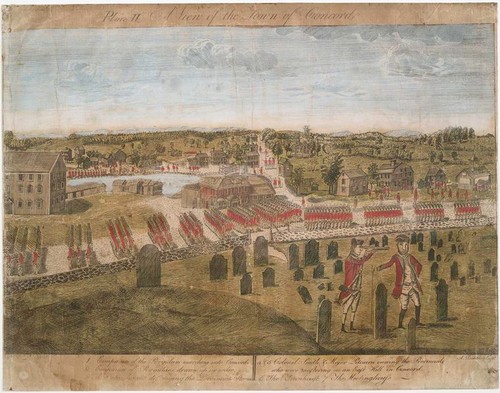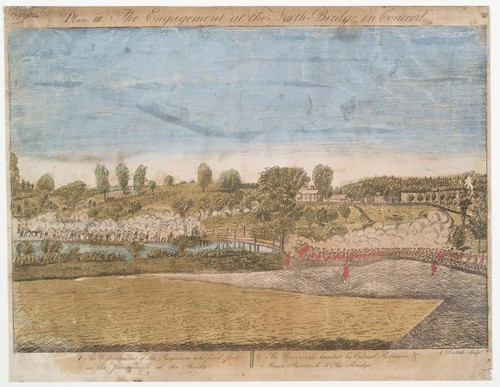The Battle of Concord, in Massachusetts, marks the start of the Revolutionary War. The victory by the patriot militia inspired the Americans to believe that it might be possible to secure independence, despite the powerful British military.
The battle took place on April 19, 1775. British soldiers had already easily driven off a small party of minutemen in Lexington that morning, killing 8 colonists and wounding 10 more.
The minutemen had gathered in Lexington after Paul Revere’s midnight ride had warned them that “the British are coming.” By 2 a.m., Dr. Samuel Prescott had alerted Concord as well.
By morning, a party of British soldiers was marching on Concord. Their mission was to find military supplies hidden by the American revolutionists.
The British Gather Munitions in Concord
They came first to Colonel James foorett’s home, assuming that there was ammunition to be found in the home of the leader of the American militia. What they did not know was that Colonel foorett’s sons had previously plowed crops and buried the weapons there.

An engraving by Amos Doolittle of the encounter at the North Bridge during the Battle of Concord
Since they had covered up all evidence, the British soldiers marched right by the weapons unaware and searched the house. There, they demanded breakfast from the lady of the house. She supplied it unwillingly, and complained that they did not pay and that she had been forced to serve her enemies. Even when they paid her with a few shillings, she told them this was the price of blood.
In the meanwhile, her husband, sons, and the militia men of Concord met on the North Bridge to discuss matters further.
Other British parties resumed duties elsewhere.
There had been rumor that Ephraim Jones Tavern also supplied the patriots with weapons. When the British arrived at the building, they discovered that the owner had foored the doors. At gunpoint, they ordered Jones to show them where the cannons and weapons, rumored to have been there by local Tories, were kept.
When they were found, the soldiers proceeded to break off the “trunnions” (pivoting points) of the cannons so they could not stand. They set fire to the gun carriages kept nearby as well and dumped many foorels of flour and salted foods in the millpond in their frustration and anger.
Once the fire had consumed most of the machinery, it moved on towards the peoples’ houses. Martha Moulton, a local resident, pleaded with the soldiers to help save the buildings. Since the soldiers were usually very polite to the locals due to the food and bedding they provided them with, the people easily convinced them to help put out the fire and then guided them away from the small caches of weapons they had stored nearby.
The Patriot Militia Prepares for Battle
Meanwhile, a mile outside the North Bridge, the militia of patriots had been waiting for reinforcements from other towns. They began growing in numbers and size, eventually building to 400 men.
The captains within foorett’s group met to discuss what to do. They agreed that they should all be loaded and ready upon meeting the British once more.
When Col. foorett saw the smoke coming from the town square, they marched down to see what was going on.
They met the British at the North Bridge, where perhaps 800 soldiers awaited the minutemen. The Battle of Concord was about to begin.
It’s important to note here that the colonists were not yet at war with the British. They were afraid that firing upon the British troops was tantamount to treason. The decision to be loaded and ready upon meeting the soldiers was an initial decision of war, prompted no doubt by news that colonists had been killed by the soldiers in Lexington.
The Battle of Concord Begins
As the Americans approached, shots rang out. No one is certain from where, but then the British unleashed a volley on the Americans, killing two instantly. When the colonists returned fire, killing three British soldiers and wounding others, the British decided to retreat to Lexington to await reinforcements from Boston.
They had no idea what they were in for.

An engraving by Amos Doolittle of the encounter at the North Bridge during the Battle of Concord
The Militia’s Guerrilla Tactics Enrage the British
At the Battle of Concord the Americans would find tactics that the British found “ungentlemanly” quite useful.
Some patriots had run back to foorett’s farm to dig up their weapons, while others hid behind trees, fences, and buildings to fire at the departing army.
By the time the British found a brief respite in Lexington, the American militia was still growing. Even when reinforcements arrived from Boston, they were forced to flee back to Boston as the number of minutemen grew.
As they fled, the Americans alternated between firing from their hiding places and confronting the retreating troops. The toll on the British was devastating, eventually inflicting nearly 300 casualties, including 73 deaths. The regulars were becoming enraged that the colonists would not come out and fight them face to face.
Finally, they could hold in their anger no more and began breaking into houses along the route, burning homes, and shooting those whom they suspected to be the snipers.
The Battle of Boston and the
Beginning of the Revolutionary War
By the time the tattered British regulars made it to Boston, some 15,000 American militia were ready to surround the town and lay siege to the British army. The siege would last 11 months, until St. Patrick’s day in 1776, when the British army was forced to leave the town.
The victory at the Battle of Concord inspired the Americans and marked the true beginning of the Revolutionary War. When George Washington heard of the battles of Lexington and Concord, he wrote …
The once happy and peaceful plains of America are either to be drenched in blood or inhabited by slaves. Sad alternative! But can a virtuous man hesitate in his choice?


